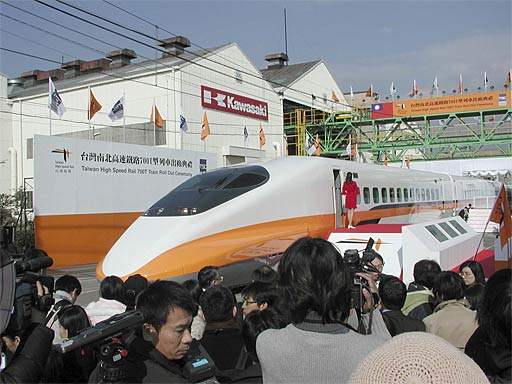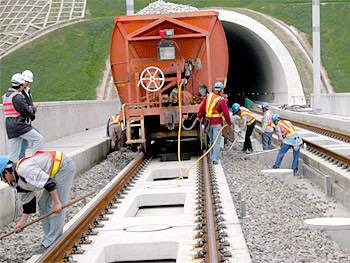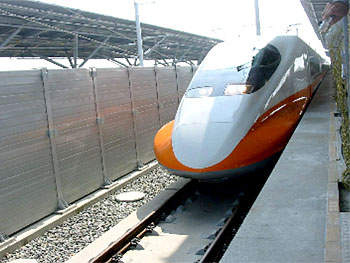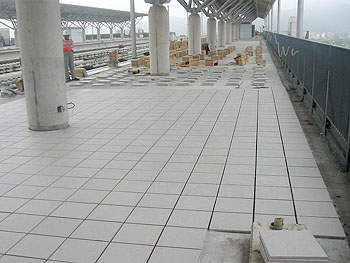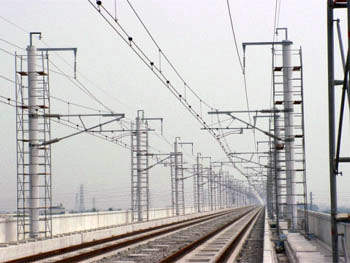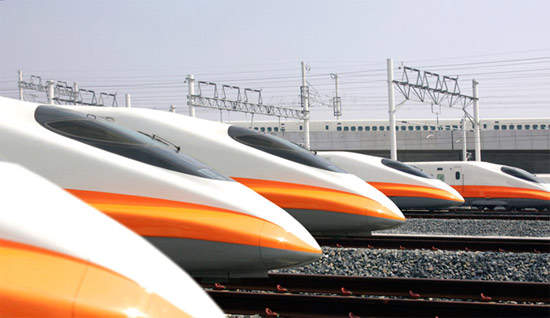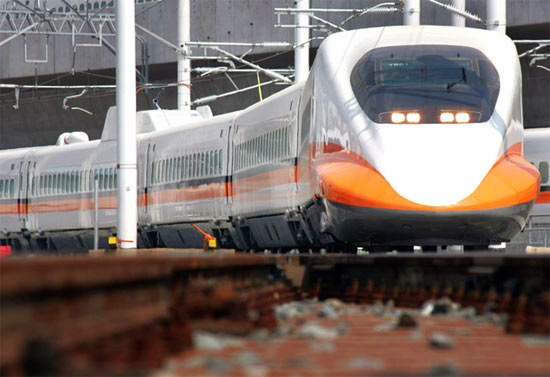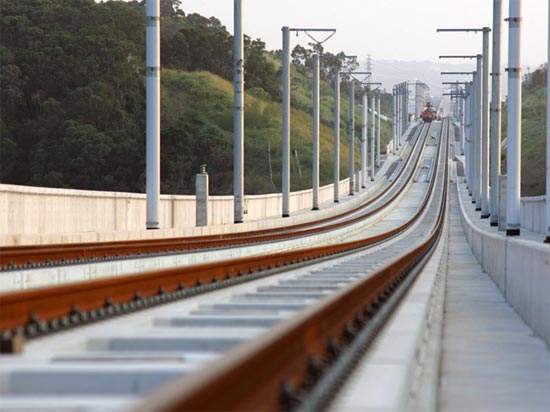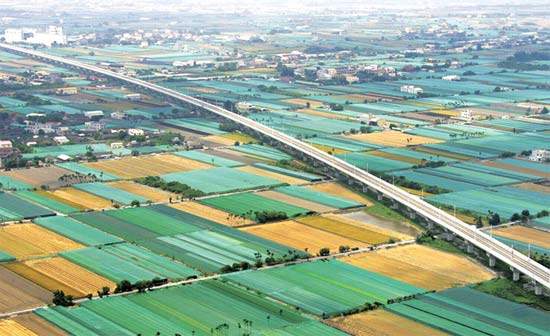After months of delays and false starts, Taiwan’s 345km (220 mile) high-speed line between Taipei and Kaohsiung finally opened for service on 5 January 2007, when the first fare-paying passengers boarded a 700T trainset at Panchaio station.
Plans were first drawn up for a high-speed rail line between Taipei and Kaohsiung, Taiwan’s two largest cities, in the early 1990s, and the route is seen as a major threat to passenger volumes by airline companies, due to rail fares being lower than air.
Plans for the high-speed line were developed to tackle continuing growth in traffic between the ‘big two’ cities, with Government officials looking to the example of Japan with its well-advanced system of dedicated high-speed routes linking major cities. These high-speed routes are widely-acknowledged as having transformed medium and long-distance travel between major population centres in the country.
The turbulence experienced by the Asian economies in the late 1990s led to many other plans for similar high-speed rail lines being either scaled down, or abandoned completely. The Taiwan high-speed project has also had a turbulent time, with deadlines changing 2006 until finally the official opening took place on 5 January 2007.
The project
Construction of the all-new high-speed line began in 2000, a 345km (220 miles) route with trains capable of 300km/h (186mph), leading to massive travel time reductions between eight major cities along the Taipei-Kaohsiung corridor.
The opening of the high-speed line has cut journey times from four hours to just 90 minutes between the two major cities.
The project is one of the largest privately-funded rail construction projects in the world. The total project is valued at $13bn and was funded by the Taiwan High-Speed Rail Corporation (THSRC) under a 35-year concession agreement, signed in 1998.
Taiwan already has a network of 2,615km (1,635 miles) with 216 stations connecting small and remote towns and cities. The old network continues to link the smaller towns, whilst the high-speed line only connects major cities.
Infrastructure
The new high-speed line was one of the largest construction projects of its kind. There are ten new stations, along with a large number of new bridges, tunnels and viaducts, so as to avoid conflicts with other forms of transport wherever possible. No less than 300km of the line’s total 345km length has been built either in tunnels or on viaducts. The route includes steep gradients to cross the terrain.
Another interesting feature, considered necessary because of the densely-populated corridor through which it passes, is a series of dedicated crossings for use by animals. The new line has been laid to double-track standards using Japanese designed slab track, with only 3km of traditional ballasted track used in the project.
The environment around the edges of the construction sites has also been protected by the uprooting and replanting of a large number of trees and plants, to provide a natural screen between the line and nearby settlements wherever possible.
Rolling stock
Initially, THSRC looked at German and French high-speed technology, which went as far as a test train being assembled using German ICE power cars and French TGV Duplex intermediate trailers for demonstration test runs in northern Germany.
After much deliberation, Japanese technology was chosen, using Kawasaki’s 700 series Shinkansen trains as a model. The finished product has been classified 700T and the first train was completed in January 2004. A formal handover ceremony took place at Kawasaki’s Hyogo works.
The 700T has been co-developed by central Japan and west Japan railway companies and modified to suit the topography of the high-speed line. In comparison to Japan’s 700 series trains the 700T has a higher maximum speed (300km/h compared to 285km/h of the Japanese operated trains) and an exterior designed to withstand Taiwan’s hotter climate.
A total of 30 new trains have been built to serve the Taipei-Kaohsiung line, with 12 coaches capable of carrying 989 passengers in business and standard classes.
Business cars have 2+2 seating whilst standard cars have a 3+2 layout. The new fleet cost TWD100bn to build. The performance equipment has been designed to support the most intensive operational requirements as the line’s traffic grows up to 2033.
A host of safety features are to be added to the new trains, including cab-based automatic train protection (ATP), bogie stability monitoring, a passenger activated alarm system, emergency ventilation and lighting and high crash-worthy body structure design complete with energy absorbing zones to minimise impact in the event of an accident.
In August 2006 THSRC invited expressions of interest for the provision of a fleet of five diesel shunters. They are being used at the Zuoying, Wurih and Lioujia depots.
Signalling and communications
A central control room has been built to monitor and operate the entire 345km line using state-of-the-art artificial intelligence. As well as keeping the main line running, the control room also controls access to and from depots.
In-cab ATP and interlocking allow route-setting and locking functions to be performed at the stations and depots along the route. Specialist wayside systems detect unusual operating conditions such as earthquakes, high winds, flooding and landslides.
One communication system has been designed for the transfer of voice, video and data information using fibre-optic based equipment. Additional systems include telephone, radio, public address, CCTV and passenger information.
The Taiwanese Government has collaborated with VeeTIME to provide wireless network onboard high-speed trains in the country. In September 2011, VeeTIME contracted Nokia Siemens Networks to provide wireless broadband services on high-speed trains by using Wimax systems. The broadband services are expected to begin in early 2012.
The future
Testing and commissioning of the new trains and line began in 2004, and the 700T units reached 315km/h. However, in late October 2006 when the railway was due to open, testing was still being carried out to ensure a safe system for passenger use.
The new line finally opened on 5 January 2007, but even so there were major issues with ticket machines shutting down at critical moments. Despite this, THSRC had sold 180,466 tickets by 6.30pm on the evening before the official launch.
Initially THSRC expects 163,000 passengers to use the line every day, but the new trains can cater for up to 300,000, suitable for the projected growth of the line for the next 20 years.
By 2033, 336,000 passengers are expected to be carried, which will see the high-speed line account for 5.5% of the transportation market in Taiwan. The number of trains in operation is expected to rise to 54 by 2033.
Although the line starts with a maximum running speed of 300km/h, track and structures have been designed and built to withstand 350km/h operation. The only feature of the line not suitable for this is the cant of the curves, but THSPC does have tentative plans for an upgrade.
Even though no extensions to the high-speed line have been devised, the communications and signalling systems are designed to accommodate future growth.

